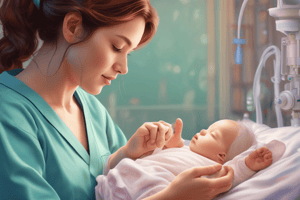Podcast
Questions and Answers
What is the typical heart rate range for a neonate?
What is the typical heart rate range for a neonate?
140-160 beats per minute
Which age group does early adulthood typically encompass?
Which age group does early adulthood typically encompass?
- 0-18 years old
- 20-40 years old (correct)
- 61-120 years old
- 41-60 years old
Toddlers are typically 3-6 years old.
Toddlers are typically 3-6 years old.
True (A)
Infants @ 12 months begin to ___.
Infants @ 12 months begin to ___.
Match the age group with the corresponding vital signs range:
Match the age group with the corresponding vital signs range:
What are the vital signs for a neonate at birth?
What are the vital signs for a neonate at birth?
What can infants usually do at 6 months of age?
What can infants usually do at 6 months of age?
Toddlers typically recognize their names and faces at 3 years old.
Toddlers typically recognize their names and faces at 3 years old.
Preschool-aged children often dress __________.
Preschool-aged children often dress __________.
Match the life stage with the age range: 41-60 years old.
Match the life stage with the age range: 41-60 years old.
Flashcards are hidden until you start studying
Study Notes
Neonates and Infants
- A neonate is from birth to 1 month old, with vital signs (V/S) of RR: 40-60, HR: 140-160, BP: 70 systolic.
- At 1 month, V/S are RR: 30-40, HR: 100-160, BP: 70-90 systolic.
- At 1 year, V/S are RR: 20-30, HR: 100-120, BP: 90 systolic.
- Neonates typically weigh 3-3.5 kg, with their head accounting for 25% of their weight.
- Until 4 weeks, neonates are primarily nose breathers.
- Fontanelles should never be pressed.
- Infants at 2 months track objects, focus on objects 8-12 inches away, recognize faces, display emotions, recognize sounds, and move in response to stimuli.
- Infants at 6 months sit up in a high chair, make one-syllable sounds, raise their upper body when on their stomach, grasp toys, follow moving objects, push down with their legs, and babble.
- Infants at 12 months walk, know their name, sit without assistance, crawl, respond to "no", say "mama" and "dada", use objects, and finger feed themselves.
Toddlers and Preschool-Aged
- Toddlers (1-3 years old) have V/S of RR: 20-30, HR: 80-130, BP: 70-100 systolic.
- Preschool-aged children (3-6 years old) have V/S of RR: 20-30, HR: 80-120, BP: 80-120 systolic.
- Toddlers at 3 years old walk, run, pull and carry things while walking, climb on furniture and stairs, and recognize names and faces.
- Preschool-aged children at 6 years old hop, jump, swing, dress themselves, use forks and spoons, count to 10, and draw.
School-Age
- School-age children are 6-12 years old, with V/S of RR: 20-30, HR: 70-110, BP: 80-120 systolic.
- They identify EMTs as people who can help and may have unrealistic expectations of what EMTs can do.
- Reassure and stay honest with school-age children during assessments.
Adolescents
- Adolescents are 12-18 years old, with V/S of RR: 12-20, HR: 55-105, BP: 100-120 systolic.
- They believe they are invulnerable and may engage in risky behaviors.
- Want to be treated like adults and may benefit from private interviews.
Adulthood
- Early adulthood (20-40 years old) V/S are RR: 16-20, HR: 70, BP: 120/80.
- Middle adulthood (41-60 years old) V/S are RR: 16-20, HR: 70, BP: 120/80.
- Late adulthood (61-120 years old) V/S vary depending on health issues; they often do not want to go to the hospital and may prefer SNF or retirement communities, fighting to keep their independence.
Neonates and Infants
- A neonate is from birth to 1 month old, with vital signs (V/S) of RR: 40-60, HR: 140-160, BP: 70 systolic.
- At 1 month, V/S are RR: 30-40, HR: 100-160, BP: 70-90 systolic.
- At 1 year, V/S are RR: 20-30, HR: 100-120, BP: 90 systolic.
- Neonates typically weigh 3-3.5 kg, with their head accounting for 25% of their weight.
- Until 4 weeks, neonates are primarily nose breathers.
- Fontanelles should never be pressed.
- Infants at 2 months track objects, focus on objects 8-12 inches away, recognize faces, display emotions, recognize sounds, and move in response to stimuli.
- Infants at 6 months sit up in a high chair, make one-syllable sounds, raise their upper body when on their stomach, grasp toys, follow moving objects, push down with their legs, and babble.
- Infants at 12 months walk, know their name, sit without assistance, crawl, respond to "no", say "mama" and "dada", use objects, and finger feed themselves.
Toddlers and Preschool-Aged
- Toddlers (1-3 years old) have V/S of RR: 20-30, HR: 80-130, BP: 70-100 systolic.
- Preschool-aged children (3-6 years old) have V/S of RR: 20-30, HR: 80-120, BP: 80-120 systolic.
- Toddlers at 3 years old walk, run, pull and carry things while walking, climb on furniture and stairs, and recognize names and faces.
- Preschool-aged children at 6 years old hop, jump, swing, dress themselves, use forks and spoons, count to 10, and draw.
School-Age
- School-age children are 6-12 years old, with V/S of RR: 20-30, HR: 70-110, BP: 80-120 systolic.
- They identify EMTs as people who can help and may have unrealistic expectations of what EMTs can do.
- Reassure and stay honest with school-age children during assessments.
Adolescents
- Adolescents are 12-18 years old, with V/S of RR: 12-20, HR: 55-105, BP: 100-120 systolic.
- They believe they are invulnerable and may engage in risky behaviors.
- Want to be treated like adults and may benefit from private interviews.
Adulthood
- Early adulthood (20-40 years old) V/S are RR: 16-20, HR: 70, BP: 120/80.
- Middle adulthood (41-60 years old) V/S are RR: 16-20, HR: 70, BP: 120/80.
- Late adulthood (61-120 years old) V/S vary depending on health issues; they often do not want to go to the hospital and may prefer SNF or retirement communities, fighting to keep their independence.
Studying That Suits You
Use AI to generate personalized quizzes and flashcards to suit your learning preferences.




